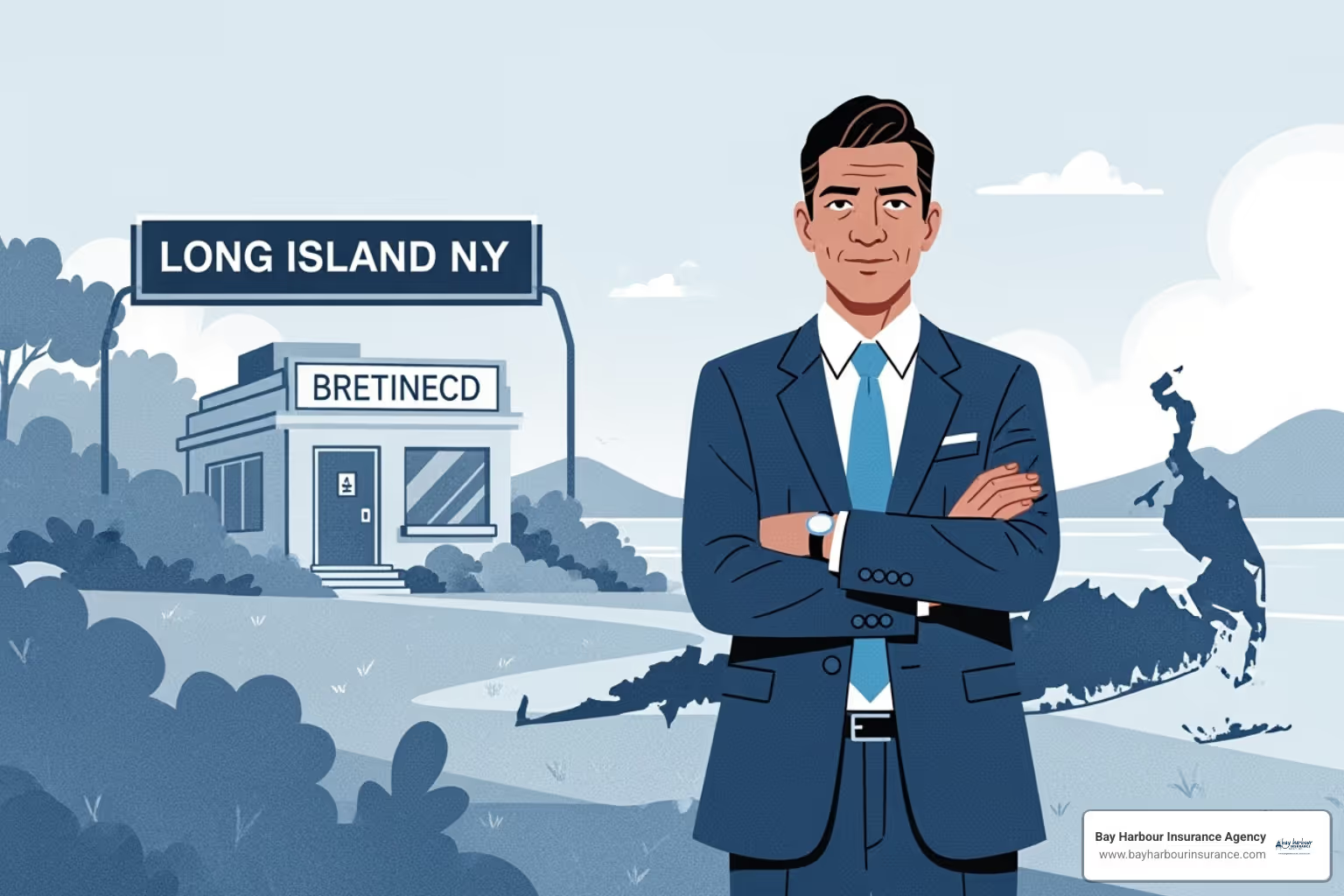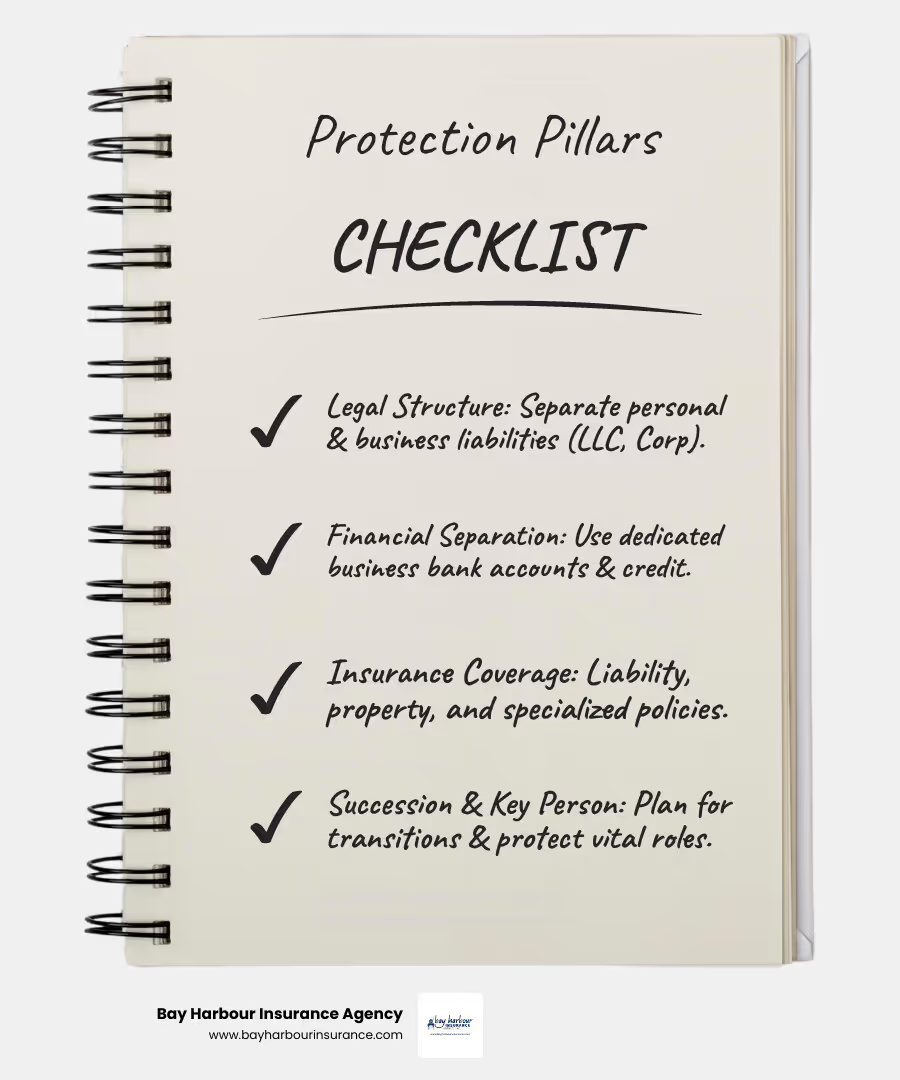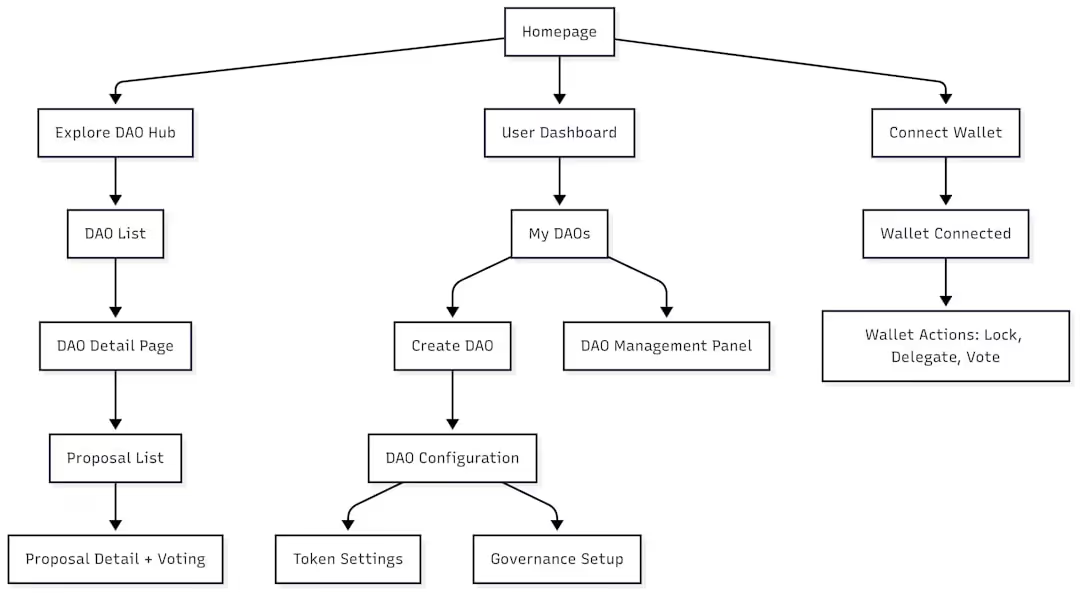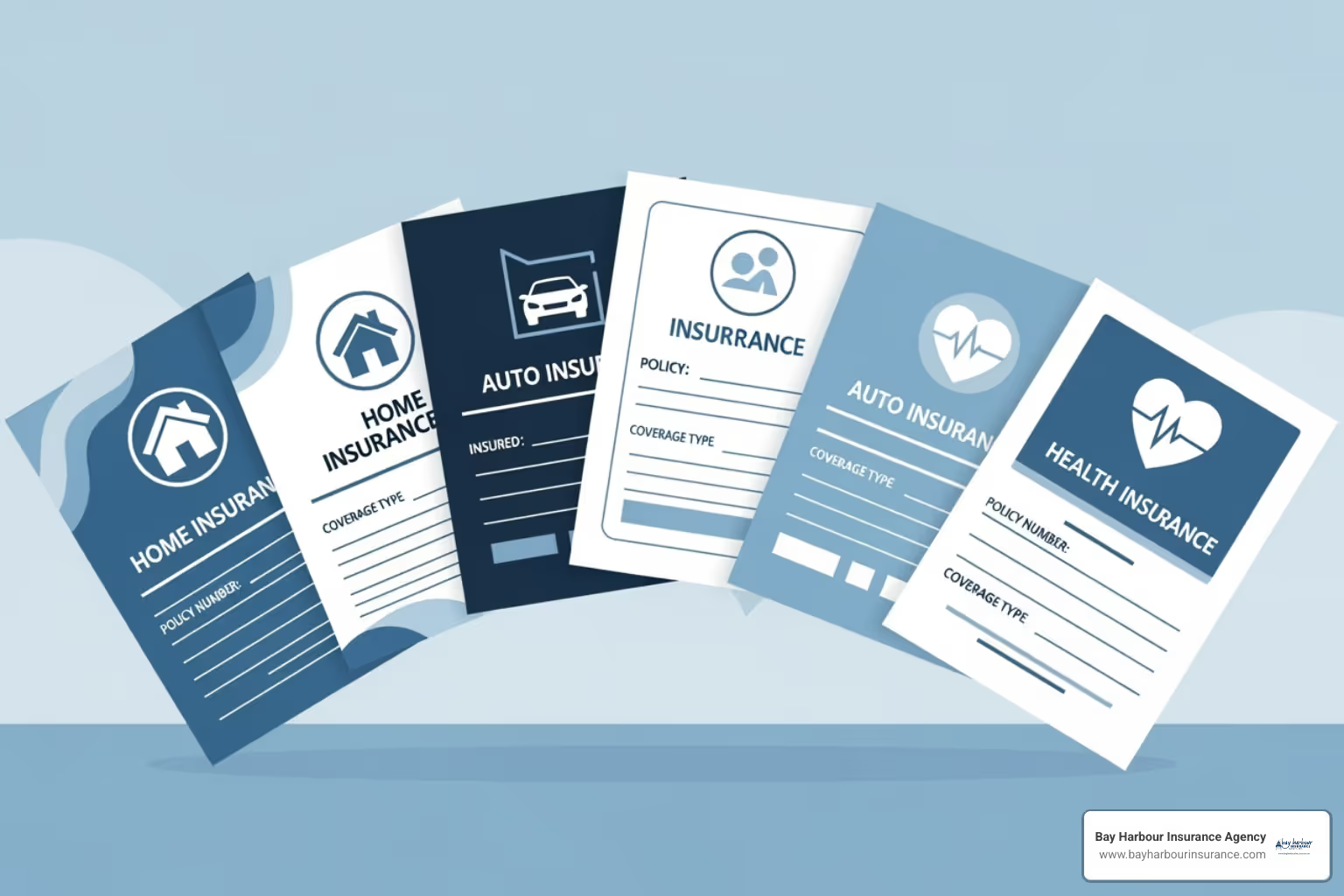
BOP It Like It's Hot: Comprehensive Protection for Business Owners
October 24, 2025
Why Business Owner Protection Matters More Than Ever
Business owner protection is a comprehensive shield against financial risks, combining legal structures, insurance, and strategic planning to safeguard your company and personal assets.
Quick Answer: Business Owner Protection Essentials
- Legal Structure: LLC or corporation to separate personal and business liabilities
- Insurance Coverage: General liability, property, and specialized policies for your industry
- Financial Separation: Dedicated business accounts to maintain legal protection
- Key Person Protection: Coverage for critical employees and ownership transitions
- Succession Planning: Formal agreements for business continuity
Running a business means taking calculated risks, but it shouldn't mean gambling with your family's financial future. As one expert noted, "The world of entrepreneurship can sometimes be a lonely dark tunnel and too often new ventures do not achieve their first anniversary."
Small businesses are uniquely vulnerable, often depending on one or two key people. The unexpected loss of a partner can have lasting impacts. Without proper protection, a single lawsuit, accident, or business disruption could wipe out both your company assets and personal savings.
The good news is you can build a fortress of protection. Each layer, from the right legal structure to comprehensive insurance, strengthens your defense against financial threats.

Laying the Foundation: Legal Structures and Financial Separation
The first line of defense for any business owner is the right legal structure and strict financial separation. These steps create a crucial barrier between your business's liabilities and your personal assets, ensuring a business setback doesn't become a personal catastrophe.

Business liabilities, such as debts or lawsuits, are an inherent part of operating. Personal assets include your home, car, and personal bank accounts. Without safeguards, these can be exposed to business liabilities, a situation known as "piercing the corporate veil." Our goal is to prevent that.
Choosing the Right Business Structure
Your business structure significantly impacts your personal liability.
- Sole Proprietorship: Simple to set up, but offers no personal asset protection. All liability rests with you personally, putting your savings and home at risk.
- Partnership: A general partnership exposes all partners to personal liability for business debts and the actions of other partners.
- Limited Liability Company (LLC): A popular choice that creates a separate legal entity, shielding your personal assets from most business liabilities. Creditors can typically only pursue assets owned by the LLC.
- Corporation (C-Corp or S-Corp): Offers the strongest personal liability protection as a distinct legal entity separate from its owners. This structure has more formal operating requirements.
Choosing the right structure is a critical first step. For more guidance, resources like the SBA provide excellent insights.
The Importance of Separating Finances
Even with the right structure, failing to separate personal and business finances can undo your hard work. Commingling funds can lead to courts "piercing the corporate veil," nullifying your liability protection.
Here’s how to ensure a clear separation:
- Open a Dedicated Business Bank Account: All business income and expenses should flow through this account.
- Use a Business Credit Card: Keep business and personal spending distinct.
- Maintain Accurate Financial Records: Keep meticulous records of all transactions. This aids in tax preparation and provides clear evidence of financial separation.
Using Trusts for Advanced Asset Protection
Trusts can offer an additional layer of business owner protection. Transferring personal assets into a family trust can be "a great start" for protecting them from commercial risk. A trust legally separates assets from your personal ownership. Irrevocable trusts, where you give up control, offer the strongest protection because the assets are no longer considered yours.
Strategic property titling also helps. Placing business real estate in a separate LLC or trust can isolate it from your main business's operational liabilities. However, it's crucial to consult with legal counsel. Lenders may require personal guarantees or security over trust assets, which can negate the trust's protective benefits.
Insuring Your Enterprise: Essential Business Insurance Coverage
Once you've built a solid legal and financial foundation, the next crucial layer of business owner protection is comprehensive insurance. Insurance is your business's safety net, catching you when unexpected events could otherwise derail your hard work.

Businesses face a range of daily risks: a customer slip-and-fall, a data breach, or a storm that forces a temporary closure. Without proper insurance, any of these could drain your accounts. The right insurance strategy covers common threats like general liability, commercial property damage, cyber liability, and business interruption.
The Business Owner's Policy (BOP)
For most small businesses, a Business Owner's Policy (BOP) is the perfect starting point. It bundles three essential coverages in one cost-effective package.
- General Liability Insurance is the cornerstone, covering customer injuries on your property or property damage your business causes to others.
- Commercial Property Insurance protects your physical assets—your building, equipment, inventory, and furniture—from damage by perils like fire or wind.
- Business Interruption Insurance replaces lost income and covers ongoing expenses (like rent and payroll) if you're forced to temporarily close due to a covered event.
To explore how a BOP might work for your business, take a look at our comprehensive Business Insurance offerings.
Specialized Liability Coverage
While a BOP is broad, many businesses need specialized protection.
- Professional Liability Insurance (Errors and Omissions or E&O) is essential if you provide advice or services. It protects you from claims that your professional mistakes caused a client financial harm.
- Directors and Officers Insurance protects key leaders from personal lawsuits arising from their management decisions. Understanding the Directors and Officers Insurance Basics can help you decide if it's right for your structure.
- Cyber Liability Insurance is vital for all businesses today. It protects you from internet-based risks and covers losses from data breaches, hacking, and cyber extortion. The risks of operating without it are severe, as we've seen with The Risks of Operating Without Cyber Insurance.
Protecting Your People and Property
Beyond liability, other insurance types are crucial for complete business owner protection.
- Workers' Compensation Insurance is typically required by law for businesses with employees. It covers medical expenses and lost wages for work-related injuries and protects you from lawsuits.
- Commercial Auto Insurance is necessary if your business uses vehicles for any operations, covering accidents and liability.
- Equipment Breakdown Insurance covers repair or replacement costs when essential equipment like HVAC systems or servers fails due to internal mechanical issues not covered by standard property insurance.
- Commercial Flood Insurance is critical on Long Island. Standard property policies exclude flood damage, so this separate coverage is essential.
The key difference between General Liability and Professional Liability is simple: General liability covers physical harm and property damage to others. Professional liability covers financial losses to clients from your professional services. Most businesses need both.
The Human Element: Comprehensive Business Owner Protection
Your business's most valuable asset is its people—you, your partners, and key employees. Protecting this human element is a critical,, part of a business owner protection strategy.

Most small businesses are highly dependent on one or two individuals. If something happens to a key person, the effects can be devastating. The good news is you can plan for these scenarios before they become crises.
A Safety Net for the Owner: Disability and Critical Illness Insurance
What happens if you suddenly can't work for an extended period? Personal financial stress hits first.
- Disability insurance acts as your financial lifeline, replacing a significant portion of your income if illness or injury prevents you from working. This prevents you from draining your business's cash flow to cover personal bills.
- Critical illness insurance pays a lump sum if you're diagnosed with a serious condition like cancer or a heart attack. This tax-free money can be used for medical treatments, home modifications, or to cover business overhead while you recover.
For entrepreneurs, income protection is crucial because there's no employer safety net.
Safeguarding the Business with Key Person Insurance
Every business has valuable employees whose departure would create serious problems. Key person insurance places life or disability coverage on these individuals, with the business as the beneficiary. If something happens to them, the insurance payout helps you manage the crisis. The funds can be used for mitigating loss by hiring temporary consultants, funding replacements, or reassuring clients and lenders that the company remains stable. It gives you breathing room to make good decisions rather than desperate ones.
Ensuring Smooth Transitions with Buy-Sell Agreements
If you have partners, a buy-sell agreement is essential. These legal contracts are a roadmap for ownership transitions, spelling out what happens when an owner leaves, retires, becomes disabled, or passes away. The agreement establishes how to value the business, gives remaining owners the first right to purchase shares, and, most importantly, provides funding for buyouts through life insurance policies on each owner.
If a partner passes away, the life insurance provides the cash to purchase their shares from their estate. Their family gets fair compensation, and you maintain control. It's a win-win that provides shareholder protection and simplifies estate planning for everyone involved. Regular reviews are key to ensure your agreements are current and properly funded.
Future-Proofing: Plan Maintenance and Succession
A solid business owner protection plan needs regular care to remain effective. As your business grows and risks evolve, a plan that was perfect last year might have dangerous gaps today. Smart business owners treat protection planning as an ongoing process, not a one-time task.

The Long Game: Benefits of Succession Planning
Every business owner eventually exits their business. Succession planning is your roadmap for that inevitable transition, ensuring your life's work continues to thrive. It's not just about retirement; it's about being prepared for any scenario.
A good plan addresses:
- Ownership transition: Outlines how shares will transfer, whether to family, employees, or an outside buyer, which can save thousands in taxes and prevent disputes.
- Management transition: Identifies and prepares future leaders to ensure operational continuity.
- Business valuation: Knowing your business's worth informs insurance coverage, buyout agreements, and retirement planning.
Succession planning minimizes disruption for employees, customers, and your family, helping to preserve your legacy.
Staying Current: Reviewing Your Business Owner Protection Plan
If it's been over two years since you reviewed your business owner protection plan, you're likely underprotected. An annual review is recommended, especially after significant changes.
Key triggers for a review include:
- Business growth and changes: As revenue, locations, or services expand, your coverage must keep pace.
- Changes in ownership or partnerships: Buy-sell agreements must be updated to reflect new ownership structures.
- Evolving risks: New threats like cyberattacks require modern protection strategies.
- Legal updates: Staying legally compliant ensures your protection remains valid.
- Valuation changes: If your business is worth more, your buy-sell and key person insurance amounts must be increased.
A focused conversation with your insurance team can quickly identify gaps. It's easier to make small, regular adjustments than to fix a major gap during a crisis.
Frequently Asked Questions about Business Owner Protection
We get these questions a lot from Long Island business owners. Here are the answers that matter most to protecting what you've built.
What is the most critical first step for business owner protection?
The most critical first step is establishing the correct legal structure, such as an LLC or a corporation. This creates a legal firewall between your business liabilities and your personal assets (your home, car, and savings). It's the foundation upon which all other protection strategies are built. Without it, your personal wealth is exposed to business risks.
Is a Business Owner's Policy (BOP) all the insurance I need?
A BOP is an excellent and cost-effective starting point, bundling general liability, commercial property, and business interruption insurance. However, it's rarely enough. Depending on your industry, you will likely need additional specialized coverage. If you provide advice, you need professional liability insurance. If you handle data, cyber insurance is essential. If you use vehicles for work, you need commercial auto coverage. The key is to match your coverage to your specific risks.
How can I protect my business if a key partner dies or becomes disabled?
This is where a buy-sell agreement funded by insurance is vital. The buy-sell agreement is a legal roadmap that dictates what happens if a partner exits. The insurance policy provides the cash for the remaining owners to purchase the departing partner's shares from their estate. This ensures a smooth transition, prevents the deceased's family from becoming your new, unprepared business partner, and keeps the business running without disruption or legal battles.
Your Partner in Protection
Building a successful business takes courage, but protecting it requires a smart, comprehensive business owner protection strategy. By combining the right legal structure, disciplined financial separation, and a robust insurance portfolio, you build a fortress around your business and personal assets.
This protection isn't something you set up once and forget. Your business evolves, and new risks emerge. Regular reviews are essential to ensure your coverage keeps pace with your growth. Navigating these complexities can feel overwhelming, but having the right partner makes all the difference.
As a client-centered, independent agency right here on Long Island, Bay Harbour Insurance Agency understands the unique challenges local business owners face. We're not just here to sell you a policy—we're here to help you build a comprehensive protection strategy that lets you sleep soundly at night.
Ready to take the next step? Get a business insurance quote today and let us help you secure the success you've worked so hard to build. Your future self will thank you.

